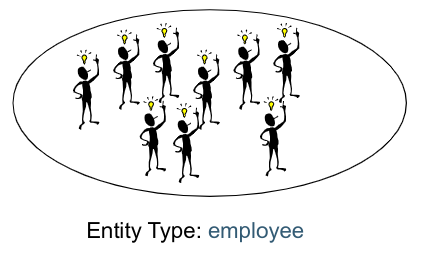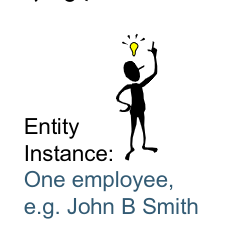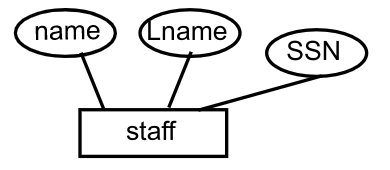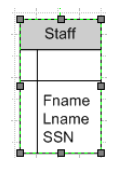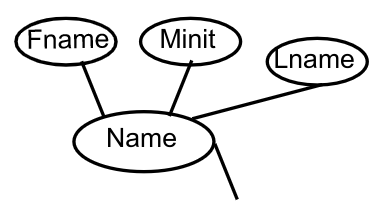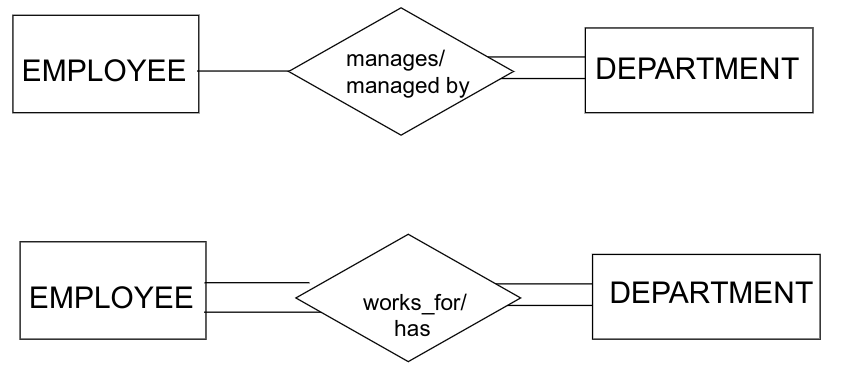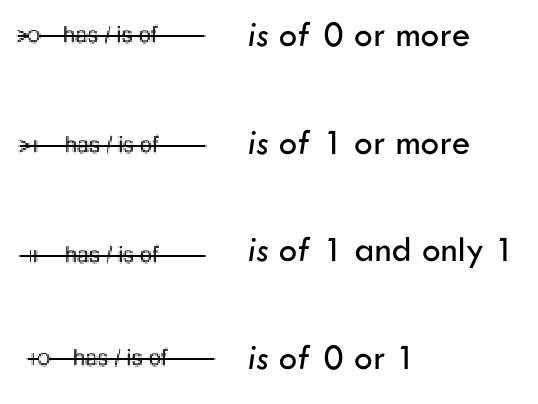18 KiB
18 KiB
- #CT230 - Database Systems I
- Previous Topic: Aggregate Clauses, Group By, & Having Clauses
- Next Topic: Joins & Union Queries
- Relevant Slides:
- What are Data Models? #card
card-last-interval:: -1
card-repeats:: 1
card-ease-factor:: 2.5
card-next-schedule:: 2022-11-19T00:00:00.000Z
card-last-reviewed:: 2022-11-18T18:34:07.942Z
card-last-score:: 1
- Data models are concepts to describe the structure of a database.
- They comprise:
- High level or logical models;
- Representational / Implementational data models;
- Physical data models.
- Data models allow for database abstraction.
- What are ER Models? #card
card-last-interval:: -1
card-repeats:: 1
card-ease-factor:: 2.36
card-next-schedule:: 2022-11-19T00:00:00.000Z
card-last-reviewed:: 2022-11-18T18:34:30.174Z
card-last-score:: 1
- Entity Relationship Models are a top-down approach to database design that provide a way to model the data that will be stored in a system. The models are then used to create tables in the relational model.
- ER Models are used to identify:
- [1] The important data to be stored in a database called entities.
- [2] The relationships between the entities.
- [3] The attributes of entities.
- [4] The constraints of relationships & entities.
-
ER Model Notation
- A number of different notations can be used to represent the same model.
- Chen Notation.
- IE Crow's Foot Notation.
- UML.
- Integrated Definition 1. Extended (IDEF1X).
- The original (Chen) notation uses diamonds, rectangles, and elipses.
- This is easier to hand-draw, so it is useful in an exam situation.
- It is less implementation-oriented than other notations.
- A number of different notations can be used to represent the same model.
-
Some Definitions
collapsed:: true-
Entities
collapsed:: true- What is an entity type? #card card-last-interval:: 3.05 card-repeats:: 2 card-ease-factor:: 2.6 card-next-schedule:: 2022-11-17T21:24:38.127Z card-last-reviewed:: 2022-11-14T20:24:38.127Z card-last-score:: 5
- What is an entity instance? #card card-last-interval:: 11.34 card-repeats:: 3 card-ease-factor:: 2.56 card-next-schedule:: 2022-11-26T00:47:05.851Z card-last-reviewed:: 2022-11-14T16:47:05.851Z card-last-score:: 5
-
Relationships
- What is a relationship type? #card
card-last-interval:: -1
card-repeats:: 1
card-ease-factor:: 2.6
card-next-schedule:: 2022-11-15T00:00:00.000Z
card-last-reviewed:: 2022-11-14T16:30:24.202Z
card-last-score:: 1
collapsed:: true
- A relationship type is a set of meaningful relationships among entity types.
- Chen's Notation: A diamond shape is used to name the relationship. 1 and M/N are used for the "1" and "many" sides respectively.
- Crow's Foot Notation: The titular "crow's foot" is used as the representation of "many", and one line is used for the representation of "1".
- Example: employee "works for" department. department "has" employee.

- What is a relationship instance? #card
collapsed:: true
card-last-interval:: 29.04
card-repeats:: 4
card-ease-factor:: 2.56
card-next-schedule:: 2022-12-10T11:35:42.874Z
card-last-reviewed:: 2022-11-11T11:35:42.874Z
card-last-score:: 3
- A relationship instance or relationship occurrence is ==a uniquely identifiable association which includes one occurrence from each participating entity type==; reading left to right and right to left.
- Example:
- Left-to-Right: John Smith "works for" Research department.
- Right-to-Left: Research department "has" John Smith.
- What is the degree of a relationship type? #card
card-last-interval:: 10.6
card-repeats:: 3
card-ease-factor:: 2.56
card-next-schedule:: 2022-11-22T01:30:24.968Z
card-last-reviewed:: 2022-11-11T11:30:24.969Z
card-last-score:: 5
collapsed:: true
- Whenever an attribute of one entity type refers to another entity type, some relationship exists.
- The degree of a relationship type is ^^the number of participating entity types.^^
- Relationship types may have certain constraints.
- What is the Cardinality Ratio? #card
collapsed:: true
card-last-interval:: 2.8
card-repeats:: 2
card-ease-factor:: 2.6
card-next-schedule:: 2022-11-20T15:15:43.390Z
card-last-reviewed:: 2022-11-17T20:15:43.391Z
card-last-score:: 5
- The cardinality ratio specifies ^^the number of relationship instances that an entity can participate in.^^
- The possible cardinality ratios for binary relationship types are:
1:1, "one to one" - at most one instance of entityAis associated with one instance of entityB.1:N, "one to many" - for one instance of entityA, there are 0 or more instances of entityB.M:N, "many to many" - for one instance of entityA, there are 0 or more instances of entityB, and for one instance of entityB, there are 0 or more instances of entityA.
-
Structural Constraints on Relationships
- Often, we may know the min & max of the cardinalities.
- Example: limit on the number of books that can be borrowed from a library.
- What are Structural Constraints? #card
card-last-interval:: 4
card-repeats:: 2
card-ease-factor:: 2.22
card-next-schedule:: 2022-11-25T13:06:19.301Z
card-last-reviewed:: 2022-11-21T13:06:19.301Z
card-last-score:: 3
- Structural constraints specify a pair of integer numbers (min, max) for each entity participating in a relationship.
- Examples: (0, 1), (1, 1), (1, N)., (1, 7).
- Often, we may know the min & max of the cardinalities.
- What is a relationship type? #card
card-last-interval:: -1
card-repeats:: 1
card-ease-factor:: 2.6
card-next-schedule:: 2022-11-15T00:00:00.000Z
card-last-reviewed:: 2022-11-14T16:30:24.202Z
card-last-score:: 1
collapsed:: true
-
Attributes
collapsed:: true- What are Attributes? #card card-last-interval:: -1 card-repeats:: 1 card-ease-factor:: 2.6 card-next-schedule:: 2022-11-18T00:00:00.000Z card-last-reviewed:: 2022-11-17T20:19:08.122Z card-last-score:: 1 collapsed:: true
- What are key attributes? #card
card-last-interval:: 5.52
card-repeats:: 3
card-ease-factor:: 2.46
card-next-schedule:: 2022-11-20T04:37:24.678Z
card-last-reviewed:: 2022-11-14T16:37:24.678Z
card-last-score:: 3
collapsed:: true
- Each entity type must have an attribute or set of attributes that ^^uniquely identifies^^ each instance from other instances of the same type.
- A candidate key is an attribute (or combination of attributes) that uniquely identifies each instance of an entity type.
- A primary key (PK) is a candidate key that has been selected as the identifier for an entity type.
- What is a composite attribute? #card card-last-interval:: -1 card-repeats:: 1 card-ease-factor:: 2.46 card-next-schedule:: 2022-11-15T00:00:00.000Z card-last-reviewed:: 2022-11-14T16:46:49.892Z card-last-score:: 1 collapsed:: true
- What is a derived attribute? #card card-last-interval:: 31.05 card-repeats:: 4 card-ease-factor:: 2.56 card-next-schedule:: 2022-12-15T21:12:18.376Z card-last-reviewed:: 2022-11-14T20:12:18.376Z card-last-score:: 5 collapsed:: true
- What is a multi-valued attribute? #card
collapsed:: true
card-last-interval:: -1
card-repeats:: 1
card-ease-factor:: 2.36
card-next-schedule:: 2022-11-18T00:00:00.000Z
card-last-reviewed:: 2022-11-17T20:18:04.379Z
card-last-score:: 1
- A multi-valued attribute is an attribute which has lower & upper bounds on the number of values for an individual entry.
- For Chen's notation, multi-valued attributes can be represented by one oval inside another.
- For Crow's Foot notation, multi-valued attributes can be represented by enclosing the attribute in {curly brackets}.
- E.g., {skills}.
-
-
Total & Partial Participation
collapsed:: true- What is Total Participation? #card
card-last-interval:: 4
card-repeats:: 2
card-ease-factor:: 2.22
card-next-schedule:: 2022-11-18T20:26:04.052Z
card-last-reviewed:: 2022-11-14T20:26:04.052Z
card-last-score:: 3
- Total Participation (Mandatory Participation): ==All instances of an entity must participate in the relationship==, i.e., every entity instance in one set must be related to an entity instance in the second via the relationship.
- For example, the entity "Student" must have total participation in the relationship "enrolled" with the entity "Course" - each student must be enrolled in a course.
- Total Participation (Mandatory Participation): ==All instances of an entity must participate in the relationship==, i.e., every entity instance in one set must be related to an entity instance in the second via the relationship.
- What is Partial Participation? #card
card-last-interval:: 7.45
card-repeats:: 3
card-ease-factor:: 2.46
card-next-schedule:: 2022-11-22T02:28:50.125Z
card-last-reviewed:: 2022-11-14T16:28:50.125Z
card-last-score:: 3
- Partial Participation (Optional Participation): Some subset of instances of an entity will participate in the relationship, but not all, i.e., some entity instances in one set are related to an entity instance in the second via the relationship.
- For example, the entity "Course" would have a partial participation in the relationship "enrolled" with the entity "Student" - a course might not have any students enrolled in it.
- Partial Participation (Optional Participation): Some subset of instances of an entity will participate in the relationship, but not all, i.e., some entity instances in one set are related to an entity instance in the second via the relationship.
-
Chen's Notation for Participation #card
card-last-interval:: -1 card-repeats:: 1 card-ease-factor:: 2.22 card-next-schedule:: 2022-11-23T00:00:00.000Z card-last-reviewed:: 2022-11-22T13:38:31.943Z card-last-score:: 1 -
Crow's Foot Notation for Participation #card
card-last-interval:: -1 card-repeats:: 1 card-ease-factor:: 2.5 card-next-schedule:: 2022-11-18T00:00:00.000Z card-last-reviewed:: 2022-11-17T20:19:01.789Z card-last-score:: 1 collapsed:: true- Use the idea of Ordinality / Optionality.
- Optionality of 0: If an entity
Ahas partial participation in a relationship to entityB, thenAis associated with 0 or more instances of entityB, so the optionality sign goes besideB.- The optionality sign for an Optionality of 0 is a bar:
|
- The optionality sign for an Optionality of 0 is a bar:
- Optionality of 1: If an entity
Ahas full participation in a relationship to entityB, thenAis associated with at least 1 or more ofB, so the optionality sign goes besideB.- The optionality sign for an Optionality of 1 is a circle or "o":
\bigcirc
- The optionality sign for an Optionality of 1 is a circle or "o":
- [And vice-versa.]
- Optionality of 0: If an entity
- In Crow's Foot notation, there is no diamond, so there is always a direct relationship line between the entities.
- The optionality sign is drawn on this line.
- The optionality drawn beside some entity
Arefers to how an instance of entityBis related to entityA.- That is, whether
Bcan be involved partially (0) or not (1).
- That is, whether
- Example in Right to Left Relationships:
- Use the idea of Ordinality / Optionality.
-
Note on Weak Entities
- Note: ^^A weak entity type always has a total participation constraint.^^
-
Chen's Notation for Weak Entities #card
card-last-interval:: -1 card-repeats:: 1 card-ease-factor:: 2.5 card-next-schedule:: 2022-11-19T00:00:00.000Z card-last-reviewed:: 2022-11-18T18:34:03.316Z card-last-score:: 1 collapsed:: true -
Crow's Foot Notation for Weak Entities #card
card-last-interval:: -1 card-repeats:: 1 card-ease-factor:: 2.5 card-next-schedule:: 2022-11-18T00:00:00.000Z card-last-reviewed:: 2022-11-17T19:36:10.883Z card-last-score:: 1 collapsed:: true- In Crow's Foot Notation, we can represent the weak entity as a normal entity, but do not choose any attributes as the primary key.
- For an attribute that partially determines the entity instances, we choose the "required" option.
- We usually represent the relationship between entities using a solid line.
- In general, with entities, there may be two valid solutions, one with a weak entity, and one without.
- There is not a huge difficulty if you do not identify weak entities in a solution so long as all the entities have primary attributes.
- It may be slightly non-optimal in terms of introducing an additional primary key that is not needed, but this is not a huge problem for us at this level.
- There is not a huge difficulty if you do not identify weak entities in a solution so long as all the entities have primary attributes.
- What is Total Participation? #card
card-last-interval:: 4
card-repeats:: 2
card-ease-factor:: 2.22
card-next-schedule:: 2022-11-18T20:26:04.052Z
card-last-reviewed:: 2022-11-14T20:26:04.052Z
card-last-score:: 3
-
Entities or Multi-Valued Attributes?
collapsed:: true- Sometimes, it may not be clear whether something should be modelled as a multi-valued attribute or an entity.
- Both may be equally correct, as long as you represent all the information that you are asked to.
- You may see (very little) difference between the two approaches if you map either approach to tables in a database.
- Sometimes, it may not be clear whether something should be modelled as a multi-valued attribute or an entity.
-
Steps to Create an ER Model
-
- Identify entities.
- Identify relationships between entities.
- Draw entities & relationships.
- Add attributes to entities (& relationships, if appropriate).
- Add cardinalities to relationships.
- Add participation constraints (total or partial) to relationships.
- Check that all entities have primary keys identified.
-
-
Mapping ER Models to Tables in the Relational Model
- Once you have you ER diagram, you now need to convert it into a set of tables so that you can implement it in a relational mode.
- Example: As MySQL tables using
CREATE TABLEScommands.
- Example: As MySQL tables using
- This stage is called Mapping ER Models to Tables in the Relational Model, and it specifies a set of rules that must be followed in a certain order.
- The rules specified here are based on Chen's Notation.
-
Steps
- [1] For each entity, create a table
Rthat includes all the simple attributes of the entity. - [2] For strong entities, choose a key attribute as the primary key of the table.
- [3] For weak entities
R, include the primary key attributes of the table that corresponds to the owner as foreign key attributes ofR.- The primary key of
Ris a combination of the primary key of the owner and the partial key of the weak entity type. - The relationship of the weak & strong entity is generally taken care of by this step.
- The primary key of
- [4] For each binary
1:1relationship, identify entitesS&Tthat participate in the relation.- If applicable, choose the entity that has total participation in the relation.
- Include the primary key of the other relation as the foreign key in this table.
- Include any attributes of the relationship as attributes of the chosen table.
- If both entities have total participation in the relationship, you can choose either one for the foreign key and proceed as above, or you can map two entities & their associated attributes & relationship attributes into one table.
- If applicable, choose the entity that has total participation in the relation.
- [5] For each binary
1:Nrelationship, identify the tableSthat represents theNside and the tableTthat represents the1side.- Include the primary key of table
Tas a foreign key inSsuch that each entity on theNside is related to at most one entity instance on the1side.- Include any attributes of the relationship as attributes of
S.
- Include any attributes of the relationship as attributes of
- For recursive
1:Nrelationships, choose the primary key of the table and include it as a foreign key in the same table with a different name.
- Include the primary key of table
- [6] For each
M:Nrelationship, create a new tableSto represent the relationship.- Include the primary keys of the tables that represent the participating entity types as foreign keys in
S- their combination will form the primary key ofS.- Also include in
Sany attributes of the relationship.
- Also include in
- For a recursive
M:Nrelationship, both foreign keys come from the same table (give different names to each) and become the new primary key.
- Include the primary keys of the tables that represent the participating entity types as foreign keys in
- [7] For each multi-valued attribute
Aof an entityS, create a new tableR.Rwill include:- An attribute corresponding to
A. - The primary key of
S, which will be a foreign key inR. Call thisK. - The primary key of
Ris a combination ofA&K.
- An attribute corresponding to
- [1] For each entity, create a table
- Once you have you ER diagram, you now need to convert it into a set of tables so that you can implement it in a relational mode.

